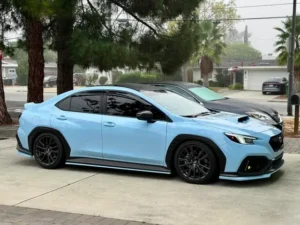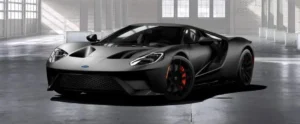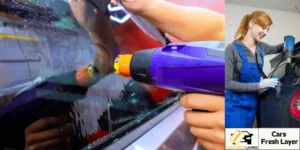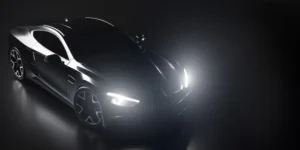Choosing between ceramic tint vs regular tint for your car windows can feel like deciding between a flowery coffee and your daily simple brew. Both do the job and are amazing, but one offers premium benefits.
Ceramic vehicle tints are known for their advanced features of heat rejection and UV protection, making your car cooler and more comfortable. That’s the reason they are gaining popularity. On the other hand, standard tints still provide decent shade and privacy at a lower cost. So, which one is worth your money?

Ceramic car tint could be your best investment if you live in a hot climate or spend long hours on the road. It blocks up to 99% of harmful UV rays, protecting your skin and car interior. Less interior fading means a cooler ride. Ceramic window film might cost more upfront, but it delivers long-term benefits.
First off, basic tint is the OG of car window fashion. While more affordable, standard window tint doesn’t offer the same heat reduction or durability. But if you’re on a tight budget, it still gets the job done for your car’s privacy and appearance. Let’s dive deeper into what sets these two tints apart.
Let’s dive into the pros and cons of these two tinting titans options. See which one gives you the best value.
Table of Contents
ToggleCeramic Tint Vs Regular Tint: Compare Before Tint
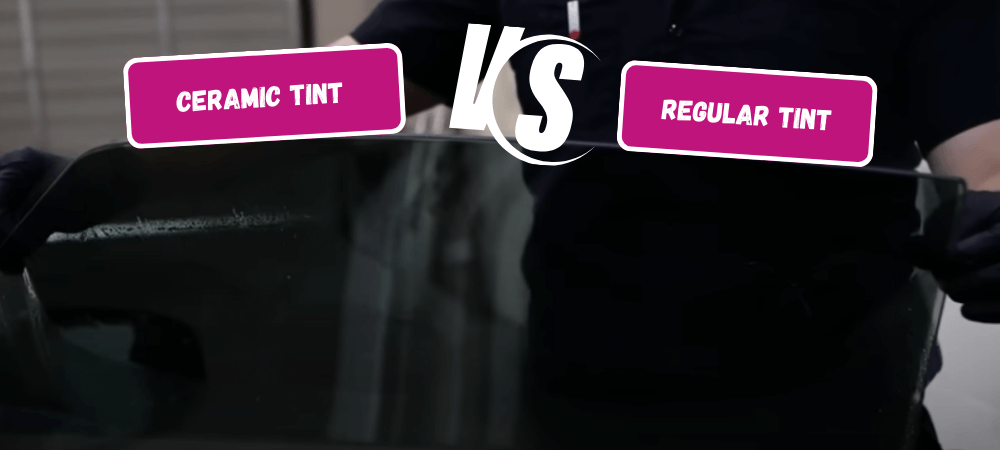
What is Regular Window Tint?: In-depth Exploration
Regular window tint, commonly known as dyed tint, is a popular type of window film prepared from polyester or laminated materials. This film features dye-infused into its layers, offering a range of colors and shades, with black being the most prevalent choice.
The tint’s darkness is measured by Visible Light Transmission (VLT) percentages, which indicate the amount of light that can pass through. For instance, a tint with a 5% VLT allows minimal light to penetrate, creating a quite dark appearance.
It has been a popular choice among car owners for its affordability and practical benefits. This type of tint primarily utilizes dyed film to reduce glare from the sun, enhance privacy, and protect the vehicle’s interior.
You won’t blink at traffic lights or struggle to see pedestrians. It blocks sunlight to help protect your car’s interior from UV rays. As a bonus, your dashboard and stuff will thank you for it!
In addition, it gives you some privacy, making it tough for nosy neighbors to peek inside your car. However, it’s not all sunshine and rainbows. Traditional tints can fade over time.
When it comes to protection, dyed window tint does an okay job. But it’s not the superhero of heat rejection. You might want to consider other options if you live in a place hotter than a jalapeno’s armpit.
Still, regular tint hits the sweet spot for many drivers between cost and performance.
What Is Ceramic Tint?: Next-Level Window Tinting
Ceramic tint is an advanced type of window film designed to improve comfort and protection in vehicles and buildings. Unlike traditional tints, advanced tint uses nano-ceramic particles instead of dyes or metals.
This unique composition allows it to block a significant amount of heat, ultraviolet (UV) rays, and glare from the sun more effectively than conventional window tints.
Ceramic UV blocking tint is a revuolationer using technology in the world of window film.
It is taking window protection to new heights. This means your car stays cooler on hot days. Plus, you can keep the AC low, saving you money on fuel!
Additionally, this tint provides superior clarity. While other tints can distort your view. Its ceramic film maintains sharp visuals.
This feature is perfect for those who enjoy a clear line of sight while driving day or night. It’s like having sunglasses for your car windows.
According to experts, it can last over decades (20 years)! So, if you want to upgrade your ride and enhance comfort, consider ceramic luxury tint. Your future self will thank you for the wise investment!
Which One is the Better Film? Ceramic vs regular Tint
When choosing window tint for your vehicle, two popular options often come up. Ceramic coating tint is generally considered superior to traditional window film due to several key factors that enhance performance, durability, and overall effectiveness.
UV Protection & Heat Rejection
When it comes to blocking harmful UV rays and managing heat inside your vehicle, ceramic tint and regular tint deliver vastly different performances. Ceramic premium tints significantly outperform regular tints in both UV protection and heat rejection, making them the preferred choice for many vehicle owners.
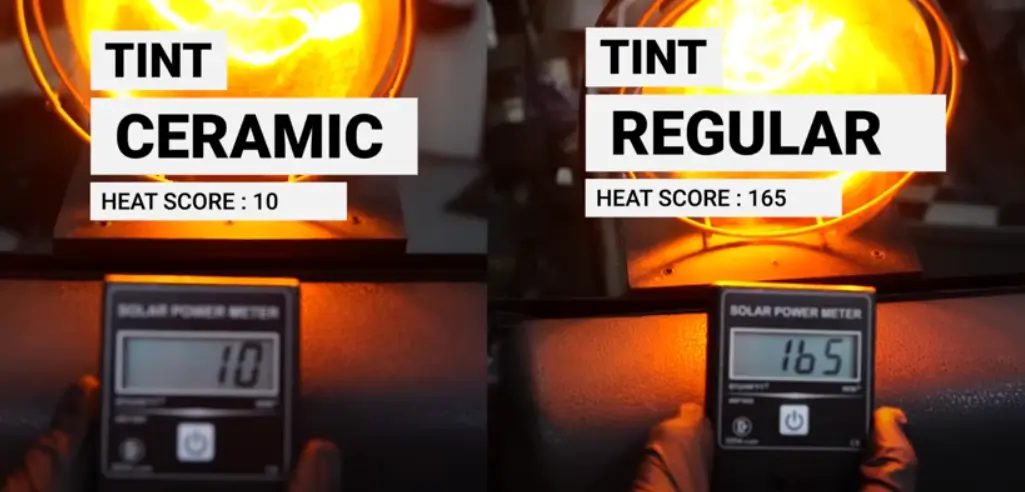
Ceramic window tint blocks up to 99.9% of harmful UV rays, including UVA and UVB, which are known to cause skin damage and fading of vehicle interiors. This high level of protection is crucial for maintaining both personal health and the longevity of a car’s interior materials.

It preserves upholstery, dashboards, and other surfaces from cracking and fading. Improves fuel efficiency by reducing the need for air conditioning.
Dyed window tint provides some level of UV protection, but it is generally much lower than that offered by ceramic coating films. They may allow a significant percentage of UV rays to penetrate, which can lead to skin exposure and interior damage over time. It offers low to moderate heat rejection.

For hot or sunny regions, ceramic nano tint is a smart investment that protects both your health and your car.
Glare Reduction
Reducing glare is crucial for safe and comfortable driving, especially during sunny days or at night when headlights from other vehicles can be distracting.
Offers superior glare reduction, even in brighter conditions. Provides a more natural view, reducing strain on the eyes. Minimizes glare from the sun, headlights, and reflective surfaces.
Offers decent glare reduction for budget-conscious users but may not perform well in extreme conditions.
Normal reduces glare moderately, depending on the darkness of the tint. Dyed tints primarily absorb sunlight, cutting down on glare to a certain extent.
Metallic tints reflect light more effectively than dyed tints, offering slightly better glare reduction. Some types of factory window tint may create haziness or darken the view excessively, impairing visibility and making it more challenging to see the road.
The limited glare reduction capabilities can lead to increased eye strain and discomfort for drivers, particularly in bright sunlight.
Provides exceptional glare reduction, making it ideal for those seeking maximum comfort and safety, especially during long drives or in areas with intense sunlight.
Material Cost & Composition
A thin layer of dyed polyester that provides basic UV protection and a slightly darker appearance. This type of tint is made from advanced nano-ceramic technology, which consists of tiny ceramic particles that are non-metallic and non-conductive.
Ceramic tints are generally more expensive than affordable window tints due to their advanced technology and superior materials.
For instance, installation costs for ceramic tint can range significantly higher than those for entry-level window tint estimates suggesting a difference of about $200 to $300 depending on the vehicle and specific product used.
Lifespan
When considering window tinting options for vehicles, they present distinct features, benefits, and drawbacks.
Ceramic window tint is known for its exceptional durability and is resistant to fading, peeling, and scratching. It can last the entire lifespan of the vehicle without significant degradation, making it a cost-effective choice over time despite its higher initial price.
While initially cheaper, non-ceramic window tint tends to degrade faster due to exposure to sunlight, leading to more frequent replacements. This can result in higher long-term costs despite the lower upfront investment.
Which One Should You Choose?
Ceramic tinting is cost-effective and easy to install; ideal for budget-conscious individuals. However, it may fade and provide less UV protection over time.
Regular tinting offers superior UV protection and heat rejection, making it a great long-term investment despite the higher upfront cost.
Choose the tint that best fits your needs and lifestyle!
Is Ceramic Window Premium Tint Worth It?
Ceramic window tint is worth it for many car owners. It offers superior UV protection, reducing interior fading and heat.
Ceramic tint does not interfere with electronic devices like GPS or mobile phones. Although it costs more, typically around $400 to $800, the benefits outrank the price. It keeps your car cooler, improving comfort and protecting your investment.
In summary, ceramic window tint provides excellent protection and comfort, making it a valuable upgrade for your vehicle.
Ceramic Window Tint Vs Metallic
Choosing between ceramic and metallic tint involves weighing the benefits of advanced technology and performance against initial cost.
Ceramic tint offers superior protection, durability, and aesthetics, making it a worthwhile investment for those seeking long-term benefits. Conversely, the metallic tint may appeal to budget-conscious consumers.
Metallic Window Tint
- Good but less effective than ceramic
- Blocks about 50% of UV rays
- Potential interference with signals
- Prone to fading and peeling
- Reflective appearance
- More affordable upfront
- Less impact on fuel efficiency
Window Ceramic Tint
- Up to 90% infrared light rejection
- Blocks up to 99% of UV rays
- No interference
- Highly durable, resistant to fading
- High clarity, natural look
- Higher initial cost
- Can improve fuel efficiency by ~5%
Conclusion
Ultimately, your choice between ceramic and standard tint film depends on your needs and budget. If you prioritize cost, regular tint might be suitable. However, ceramic tint is worth considering for superior protection and longevity.
When deciding, weigh the benefits against the drawbacks. Consider how long you plan to keep your vehicle. Additionally, think about your local climate. Both types have their place in the market, so choose what fits your lifestyle best.
For more insights, check out our infographic on window tinting costs by vehicle type!



